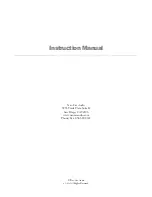
DE5802
1
'/%
Automatic Telephone Dialer
Installation Instructions
,1752'8&7,21
The Visonic Ltd. DL-125B Automatic Telephone Dialer initiates
telephone communications upon receipt of a trigger pulse, and is
intended for unattended operation at a remote location. It dials
preprogrammed numbers and then transmits either an identifying
alarm code or an optional voice message from an external
source. A non-volatile memory includes 9 memory cells for
retaining 9 telephone numbers (Cells 1 to 9) and a single memory
cell (Cell 0) for storing one of 10 possible identification codes. An
identification code contains a sequence of swept-tone bursts –
from 1 to 10 bursts – as programmed by the installer. This
sequence is repeated at 3-second intervals within a 60-second
time frame. The Dialer's operation routine is as follows:
1. When The DL-125B receives an input trigger pulse, it
disconnects any telephones that are connected to the
telephone line via its SET terminals, and dials the
programmed number in Memory Cell No 1.
2a. If no external audio device is connected, the dialer repeatedly
transmits its identification code for approximately one minute.
If that code consists, for example, of three rising tone bursts
(Code 3), three 1/2 sec bursts are transmitted, separated by
intervals of 1/2 sec (1 Hz). The three bursts are repeated at
3-second intervals for one minute.
2b. If a source of external audio, such as a cassette player or an
electronic speech processor is connected, it is switched on
and the recorded message is transmitted.
3. The dialer then hangs up and switches off the audio source, if
used, and immediately dials the telephone number in Memory
Cell No. 2. It transmits its identification code or audio
message for approximately one minute, as in Step 2. A
closed-loop cassette should be used in the tape recorder.
4. The dialer repeats Step 3 for the third telephone number and
so on until it completes the process with the last programmed
telephone number.
5. The entire cycle is repeated once more for all of the
programmed telephone numbers, and then the dialer
disconnects itself and reconnects the telephones sharing the
line with it.
Note: The shortest complete cycle occurs if a single telephone
number is programmed: that number is dialed twice. The longest
cycle consists of nine telephone numbers: 18 numbers are
dialed. If the same number is programmed into all 9 available
memory cells, that number is dialed 18 times.
63(&,),&$7,216
GENERAL
Input voltage: 10.5 to 16 VDC
Standby input current: none.
Operating input current: 120 mA at 12 VDC
Dimensions: 7 x 10 cm
TELEPHONE LINE
Dialing method: Pulse, 10 pps
Telephone numbers: 1 to 9, with programmable priorities
Digits per telephone number: 1 to 16, programmable
EXTERNAL AUDIO
External audio input impedance: Approximately 500 ohms,
capacitor coupled
External audio input level: 0 dBm nominal
Duration of audio input signal: 45 seconds maximum
External audio switching contacts: 24 VDC, 2 A maximum
,167$//$7,21
(/(&75,&$/&211(&7,216
Ground An external ground terminal, to establish a protective
ground for the telephone lines. This terminal is
electrically isolated from the circuit ground of the
Automatic Dialer.
LINE
Terminal pair for connecting any standard telephone line
utilizing pulse dialing. The four SET, LINE and ground
terminals are isolated from the other terminals of the
Automatic Dialer.
SET
Terminal pair for connecting rotary or pushbutton
telephone sets, using the line to which the Automatic
Dialer is connected. Ensure that all telephone sets are
connected to the line only via the SET terminals! One
terminal is common to both SET and LINE.
REM
Connect a normally open switch between this terminal
and the 12V (+) terminal. Closing the switch for at least
100 ms (0.1 sec) actuates the Automatic Dialer; to
reduce false triggering, shorter closures are ignored.
12 V
Terminal pair for connecting a source of 12 VDC.
AUD
Connect this terminal to an optional source of external
audio, usually the center conductor of the earphone jack
of a cassette player. Bring the outer conductor to the
12V (–) negative supply terminal.
TAPE
These are floating, normally open contacts, to switch on
an external audio source (a cassette player or an
electronic speech processor). If such a device is used,
install a jumper across the two TAPE pins on the printed
circuit board. If a source of external audio is not used,
place the TAPE jumper on a single pin to prevent losing
it.
PROG
Connect this terminal to the 12V (+) to switch the dialer
to the programming mode. The same result is obtained
by placing a jumper across the two PROG pins on the
printed circuit board.




















